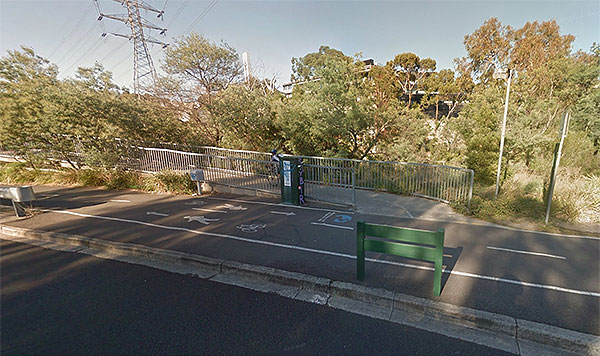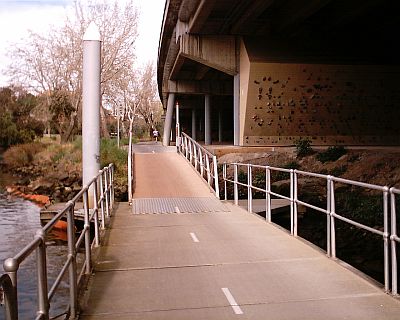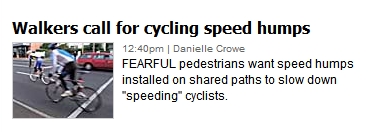I drafted this entry a few months ago but I motivated to finish it and post it now after hearing about the ludicrous suggestion from a group of walkers over in Manningham that speed humps should be installed on shared paths to slow down "speeding" cyclists.
Last November I had an encounter with a pedestrian that left me a little sad and angry.
The location
Firstly I should describe the location. At its city end the Gardiners Creek Trail crosses the Yarra River, makes a sharp-ish left-hand bend then descends to ground level down a ramp running parallel to the Yarra Trail before it joins the latter through a kind of gateway, into a Y-shaped intersection. Here's the spot on Streetview:
 Y-intersection of two paths [view on Google Maps]
Y-intersection of two paths [view on Google Maps]
Zoom in for a better look. Note the there are standard "Give Way" markings at the bottom of the ramp.
Anyway you get the idea: it's a potentially dangerous intersection where caution is required.
The incident
I was descending this ramp and, as is my usual practice, I looked over the railing back along the Yarra Trail to see if there was any oncoming foot or cycle traffic to be avoided. There was a jogger approaching on my right but the timing was such that I'd reach the junction of the trails safely ahead of her. In any case, I sounded my honker horn and proceeded onto the Yarra Trail.
Then the jogger went ballistic, shouting at me that I was supposed to give way, and more. She really served it up and before I could get a word in, she'd turned around and was off back the way she'd come.
Phew! What had I done to deserve that? I thought I'd been pretty cautious and considerate. Despite my calls to wait, she clearly wasn't hanging around to discuss things.
Now I was a bit agitated myself, and made a hasty U-turn (if somewhat ill-considered—sorry to the bloke who had to swerve around me!) and followed the jogger. I rolled up beside her and spoke politely, apologising if I had alarmed her but pointing out that I had actually taken due care and had clearly signalled my intentions. It seemed pretty clear that she wasn't specifically angry with me, rather she was just fed up generally.
What really shook me about our brief discussion was that the jogger was visibly very distressed as she told me that she'd used the Yarra and Gardiners Creek trails for years but now felt unsafe because of cyclists, especially on the Gardiners Creek trail. I agreed with her on that point, saying that I've started avoiding most of the Gardiners Creek trail because it's so busy these days.
She also said that she is frequently shouted at and abused by cyclists.
And this got me thinking
Although this was hammering it home in a way that I couldn't miss, I've long noticed that some of my fellow cyclists do show a disgraceful disregard for other trail users, both pedestrian and pedalist.
This put me in mind of concept of the dominant threat on the roads:
Is it because the transport mode which poses the greater capacity to endanger others (The Lorry as the "Dominant Threat") is legislated for and treated with, the additional responsibility which goes hand in hand with driving a vehicle capable of more damage and casualty if not driven correctly.
In other words, the duty of caution should lie with the mode of transport more likely to cause injury.
A similar concept was discussed last year on YarraBUG radio, where the argument was put forward that the legal liability for a collision between a car and a bicycle should lie with the motorist, unless and until it can be proven otherwise.
On the road, cyclists are naturally pretty much at the bottom of the victim chain; we are almost always the most likely to be injured. But on the shared paths it's a different story. Putting aside the fact that in a pedestrian-cyclist collision the chances of injury are pretty equal on both sides (or maybe even greater for the cyclist), due to weight and speed differences it is the cyclist that is the dominant threat over the pedestrian.
This is an unusual situation for the cyclist. We generally need to be a bit more combative (or at least assertive) when riding on the road, where we are almost always the least dominant threat. However, this mindset is not suitable to the shared pathways. I reckon too many cyclists forget to turn off their on-road aggression when they get off the road and onto the trails.
Not just pedestrians
And it's not just pedestrians that are given a hard time—inexperienced or slower riders are sometimes mercilessly squeezed by faster riders.
I remember another encounter with a selfish bastard at Burnley Harbour, where the ramps are a bit narrow and can be a bit scary for inexperienced riders:
 Prudent riders go one at a time on this narrow ramp
Prudent riders go one at a time on this narrow ramp
I saw Mr Selfish-Bastard coming up behind me and he clearly wasn't going to be slowed by anything—not me or the couple of trundlers who were just about to go down this ramp in front of me. I saw what was going to happen a second before it did: Mr Selfish-Bastard sped up, overtook and swerved in front of the other (clearly inexperienced) riders while they were on the ramp.
I caught up with him at the top of the hill at Loys Paddock, and our friendly discussion went like this:
ME: You know, there was no real reason to pass like that back on the ramp.
BASTARD: Well, I have an expectation that you'll keep left.
[That's rich, isn't it? Blasting by on an "expectation"—bugger due caution.]
ME: But it wasn't me that you were passing.
BASTARD: I know.
ME: Well you really scared the shit out of that woman back there.
BASTARD: I know.
ME: You don't give a shit about anyone else, do you?
BASTARD: No.
ME: You're a prick.
It staggers me that people can ride like this and with the same breath condemn motorists who drive with exactly the same might-is-right attitude.
In the media
Coincident with my run-in with the jogger were two articles that appeared in the Sydney Morning Herald, one about cyclists being 'doored' and another on a nasty shared path collision:
Drawing on Ms Guliano's case, a new study from the NSW Injury Risk Management Research Centre found that the shared zones had "increased the risk of conflict and collisions where the pedestrian is vulnerable".
It found that the potential for collisions was often exacerbated by inadequate design, the high density of users and the inability of councils to enforce basic rules such as keeping left and overtaking on the right, and predicted that the fatality rate would increase.
(It was not long after this that Harold Scruby had his little brainfart about shared paths. Remember that?)
The problem of walkers and cyclists coming into conflict on shared paths is clearly not going to go away on its own. It's interesting that the design of paths is mentioned in that study. As I ranted recently, most of Melbourne's shared paths are currently not safe and efficient transport routes.
Just as an aside, I find it interesting that the Herald Sun saw fit to pick up the Manningham walkers story and feature it on its home page as the second-top story in Victoria. Is it that important? Wow, slow news day. Here's how they presented it:
 …with a photo of road cycling?
…with a photo of road cycling?
Why did they illustrate it with a picture of cyclists riding on the road? Was it the only shot they had of cyclists with a motion blur?
Dialogue required
I have no problem at all with the Manningham residents mounting a campaign to make shared paths safer. I'm all for that. But let's not presuppose the solution, particularly a punitive solution that has the potential to make paths less safe and certainly less accessible. Hopefully Manningham Council will have the good sense to open up a dialogue with all groups of path users and find a solution that will benefit everyone.
I think that there's no one mode of transport that consists entirely of angels or jerks (ok, maybe suburu drivers). I've had pedestrians yell at me for going around them on the grass... what? I veered 2m away to pass you because you are walking down the middle of the lane with your dog off the leash and I'm the bad guy? But I've also found people who were paying attention and walking to one side, and willing to stop and give way to let bikes past when they technically could have assumed they had the right of way.
I think the point you made in a previous post - "Why is 5-10 seconds so precious out of your life" applies to everyone, not just drivers who zoom on past cars. Its also the same for cyclists, and also for pedestrians. It just also needs to be balanced by "Could you step to one side and let someone else get on with their day?"
Having recently returned from Canberra where bike paths are part of the cycling and pedestrian culture, I find it sad that pedestrians in Sydney and Melbourne cannot share the paths as they do in the ACT. It has to be something cultural. Your experiance with "BASTARD" reminds me all too much of an incident I mentioned on Sydney Cyclist. What is the difference between Canberrans and Sydneysiders and Melbournians?
What next? Mandatory dog traps on shared paths to protect pedestrians from potentially dangerous unleashed dogs?
Nice, balanced coverage. Thanks. This is the opposite to a recent TV current affairs coverage in NSW which, while appearing balanced, ended with the impression that cyclists caused their own problems by breaking the law e.g. going through traffic lights or riding between the lanes of stopped traffic. A more balanced approach would have shown that all road users - cars, cyclists and pedestrians - all break the rules, often because we can determine independently of traffic lights etc that we can do it safely. One thing I've experience often on shared paths around Wollongong is walkers spread across the full breadth of the path. Ringing bells in this situation often results in confusion in the walkers and a path blocked longer. My solution has been to warn of my approach only if the path is totally blocked.
A prick's a prick no matter whether they are in a car or on a bike or on foot. It funny how the mode of transport becomes the person. "Bloody cyclist" should be "bloody prick on a bicycle".
I don't ride often but I always assume pedestrians can't hear my approach. A tinkle on the bell doesn't seem to say "f*ck you" like a car horn does.
I really like this blog. It's always disappointing when you don't update for days.
Comments
This is why I absolutely refuse to use "shared" paths, even when it IS the best option (which is probably less than 0.01% of the time anyway). If motorists get upset that I'm riding on the road when there's a path nearby, I say Good! Hopefully they'll have a public whinge about it, and then some attention might actually be drawn to the fact that 1. most shared paths are totally substandard and usually far more dangerous than sharing the road with cars, and 2. virtually nobody who uses the "shared paths" has any idea about the concept of sharing.